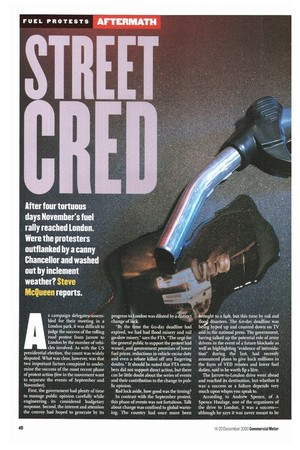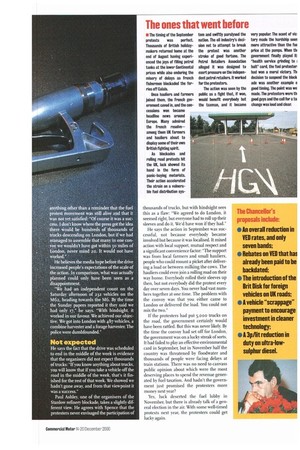After four tortuous days November's fuel rally reached London. Were
Page 42

Page 43

If you've noticed an error in this article please click here to report it so we can fix it.
the protesters outflanked by a canny Chancellor and washed out by inclement weather? Steve McQueen reports.
As campaign delegateseassembled for their meeting in a London park, it was difficult to judge the success of the rolling road protest from Jarrow to London by the number of vehicles involved. As with the US presidential election, the count was widely disputed. What was clear, however, was that two important factors conspired to undermine the success of the most recent phase of protest action (few in the movement want to separate the events of September and November).
First, the government had plenty of time to manage public opinion carefully while engineering its considered budgetary response. Second, the interest and attention the convoy had hoped to generate by its progress to London was diluted by arstinct change of luck.
"By the time the 6o-day deadline had expired, we had had flood misery and rail go-slow misery," says the FTA. The urge for the general public to support the protest had waned,.and government promises of lower fuel prices, reductions in vehicle excise duty and even a rebate killed off any lingering doubts." It should be noted that FTA members did not support direct action, but there can be little doubt about the series of events and their contribution to the change in public opinion.
Bad luck aside, how good was the timing?
In contrast with the September protest, this phase of events was not fortuitous. Talk about change was confined to global warming. The country had once more been
brought to a halt, but this time by rail and floi:40 disasters. The 6o-day deadline was being hyped up and counted down on TV add in the national press. The government, • having talked up the potential role of army drivers in the event of a future blockade as well as highlight4 "evidence of intimidation" during the last, had recently announced plans to give back millions in the form of VFD rebates and lower fuel duties, said to be worth 8p a litre.
The Jarrow-to-London drive went ahead and reached its destination, but whether it was a success or a failure depends very much upon whom you speak to.
According to Andrew Spence, of A Spence Haulage, one of the organisers of the drive to London, it was a success— although he says it was never meant to be
anything other than a reminder that the fuel protest movement was still alive and that it was not yet satisfied: "Of course it was a success. I don't know where the press got the idea there Would be hundreds of thousands of trucks descending on London, but if we had managed to assemble that many in one convoy we wouldn't have got within 5o miles of London, never mind 2o. It would not have worked."
He believes the media hype before the drive increased people's expectations of the scale of the action. In comparison, what was actually planned could only have been seen as a disappointment.
"We had an independent count on the Saturday afternoon of 232 vehicles on the M62, heading towards the MG. By the time the Sunday papers reported it they said we had only 17," he says. 'With hindsight, it worked in our favour. We achieved our objective. We got into London with 487 vehicles, a combine harvester and a forage harvester. The police were dumbfounded."
Not expected
He says the fact that the drive was scheduled to end in the middle of the week is evidence that the organisers did not expect thousands of trucks: "If you know anything about trucks, you will know that if you take a vehicle off the road in the middle of the week, that's it finished for the rest of that week. We showed w' hadn't gone away, and from that viewpoint it was a success."
Paul Ashley, one of the organisers of the Stanlow refinery blockade, takes a slightly different view. He agrees with Spence that the protesters never envisaged the participation of thousands of trucks, but with hindsight sees this as a flaw: "We agreed to do London, it seemed right, but everyone had to roll up their sleeves and do it. We'd have won if they had."
He says the action in September was successful, not because everybody became involved but because it was localised. It mixed action with local support, mutual respect and a significant convenience factor: "The support was from local farmers and small hauliers, people who could mount a picket after delivering a load or between milking the cows. The hauliers could even join a rolling road on their way home. Everybody rolled their sleeves up then, but not everybody did the protest every day over seven days. You never had vast numbers together at one time. The problem with the convoy was that you either came to London or delivered the load. You could not mix the two."
If the protesters had put 5,000 trucks on the road, the government certainly would have been rattled. But this was never likely. By the time the convoy had set off for London, the government was on a lucky streak of sorts. It had failed to play an effective environmental card in September, but in November half the country was threatened by floodwater and thousands of people were facing delays at train stations. There was no need to canvass public opinion about which were the most deserving places to spend the revenue generated by fuel taxation. And hadn't the government just promised the protesters more money next year?
Yes, luck deserted the fuel lobby in November, but there is already talk of a general election in the air. With some well-timed protests next year, the protesters could get lucky again.




































































































